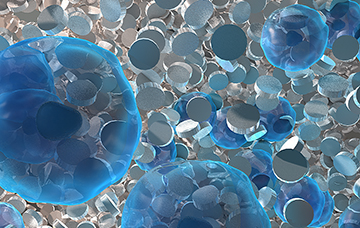NIBIB-funded researchers have designed a new class of two-dimensional (2D) nanomaterials that are disc-shaped and flat on the surface, similar to a coin, to aid in treatments for cartilage repair. The surface of the nanomaterial is negatively charged, while in contrast the edges are positively charged. This unique charge arrangement allows the nanomaterials to trap proteins or growth factors, which can be slowly released over time. The experiments were conducted in a laboratory dish, but the results showed potential for clinical application in repairing damaged cartilage.

Healthcare advances are allowing the population to live longer, causing an increase in the rate of osteoarthritis in the aging population. The CDC reports that 30 million U.S. adults are suffering from osteoarthritis, a degenerative disease where cartilage within a joint begins to break down from normal daily activity. Cartilage tissue does not have a natural mechanism to repair or rebuild itself, so over time pain, stiffness, and swelling can occur, reducing function and mobility. “Tissue engineering is complex, and researchers are taking a variety of approaches to solve health problems like cartilage repair. It is difficult to identify which approach will work best in the end, so it’s vital researchers continue building and expanding the field,” said Seila Selimovic, Ph.D., director of the NIBIB program in Tissue Engineering.
Current clinical treatments consist of painful surgeries, including joint replacement for severe cases, or various types of physical therapies combined with anti-inflammatory medications for more moderate cases. A promising, less invasive treatment where key proteins and growth factors are administered directly to sites of injury has shown improvement in cartilage repair, but adverse side effects are preventing its mainstream use. Recent clinical studies using this treatment revealed inflammation, uncontrolled tissue formation, and the breakdown of small amounts of bone tissue at locations where high doses of growth factors were released.
Akhilesh K. Gaharwar, Ph.D., assistant professor in the Department of Biomedical Engineering at Texas A&M University, said “Once growth factors are delivered, they tend to break down quickly, so to achieve a therapeutic dose a large amount is needed.” Akhilesh explained the 2D nanomaterials developed in his lab can help solve this problem because growth factors can be stored on the nanomaterial and slowly released over time, thereby stemming the negative side effects observed at higher doses.
The results, published in the American Chemical Society journal Applied Materials & Interfaces, indicated that in cell studies, the 2D nanomaterials successfully attach to growth factors and then release them slowly over a four-week period. Akhilesh and his team believe the nanomaterials will break down naturally in the body, permitting the sustained release of the growth factors. The results also showed an increase in other proteins that are critical in regenerating cartilage after the prolonged release.
A common concern with this type of study is the potential for the protein’s structure to be modified upon attachment to the nanomaterial, which may lead to unwanted alterations in the protein’s normal function. Fortunately, the researchers did not observe any changes to protein structure after binding to the nanomaterial.
Akhilesh says the next goal is to inject the nanomaterial into the small spaces between cartilage in an animal model to determine if the similar results are achieved without eliciting an unfavorable immune response. Currently, the nanomaterials are loaded with manufactured growth factors, but Akhilesh thinks growth factors produced naturally by cells in the body may also stick to the nanomaterials. The team will investigate the validity of these mechanisms in future studies as well.
The work was supported by grants from NIBIB (R03EB023454 and DP2EB026265) and the National Science Foundation.
Sustained and prolonged delivery of protein therapeutics from two-dimensional nanosilicates. Lauren M. Cross, James K. Carrow, Xicheng Ding, Abhay Singh, and Akhilesh K. Gaharwar. ACS Applied Materials Interfaces. 2019, 11, 6741-6750.
